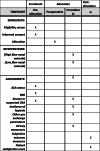High-flow nasal cannula versus standard oxygen therapy assisting sedation during endoscopic retrograde cholangiopancreatography in high risk cases (OTHER): study protocol of a randomised multicentric trial
- PMID: 32471494
- PMCID: PMC7256482
- DOI: 10.1186/s13063-020-04378-z
High-flow nasal cannula versus standard oxygen therapy assisting sedation during endoscopic retrograde cholangiopancreatography in high risk cases (OTHER): study protocol of a randomised multicentric trial
Abstract
Background: Endoscopic retrograde cholangiopancreatography (ERCP) is an increasingly common intervention in the treatment of pancreaticobiliary disorders. Patients are often elderly with complex co-morbidities. While monitored anaesthesia care with sedation is commonly used for most cases, few would require general anaesthesia with an endotracheal tube. Both low-flow and high-flow nasal cannulas (HFNC) are established ways of delivering supplemental oxygen, but it is unclear whether one technique is better than the other. HFNC seems a promising tool for advanced procedures but evidence to support its application in high-risk ERCP cases is limited. The rate of oxygen desaturation during endoscopy has been reported to be as high as 11%-50% and the method of oxygen delivery for ERCP merits further study.
Methods/design: This is a prospective, randomised, multicentre trial comparing the efficacy of oxygen supplementation through HFNC versus low-flow nasal cannula during ERCP, in a cohort of patients at risk of adverse respiratory events. A total of 132 patients will be recruited across three sites and randomly assigned to either the low-flow or the HFNC group. The primary outcome is the proportion of patients experiencing hypoxia, defined by any event of SpO2 < 90%. The secondary outcomes include parameters centred on oxygenation, requirement of airway manoeuvres, successful completion of procedure, perioperative complications, patient satisfaction and cost analysis of the consumables. An intention-to-treat principle will be applied while analysing.
Discussion: The demand for ERCPs is likely to increase in the future with the aging population. Our study results may lead to improved outcomes and reduce airway-related complications in patients undergoing ERCPs. The results will be presented at national and international meetings and published in peer-reviewed journals.
Trial registration: www.ANZCTR.org.au, CTRN12619000397112. Registered on 12 March 2019.
Keywords: Endoscopic retrograde cholangiopancreatography; High-flow oxygen cannula; Hypoxia; Low-flow oxygen cannula; Oxygen therapy.
Conflict of interest statement
None declared.
Figures


References
-
- Ashton CE, McNabb WR, Wilkinson M, Lewis RR. Endoscopic retrograde cholangiopancreatography in elderly patients. Age Ageing. 1998;27(6):683–688. - PubMed
-
- Martindale S. Anaesthetic considerations during endoscopic retrograde cholangiopancreatography. Anaesth Intensive Care. 2006;34(4):475–480. - PubMed
-
- Raymondos K, Panning B, Bachem I, Manns M, Piepenbrock S, Meier P. Evaluation of endoscopic retrograde cholangiopancreatography under conscious sedation and general anesthesia. Endoscopy. 2002;34(09):721–726. - PubMed
-
- Chen W-X, Lin H-J, Zhang W-F, Gu Q, Zhong X-Q, Yu C-H, Li Y-M, Gu Z-Y. Sedation and safety of propofol for therapeutic endoscopic retrograde cholangiopancreatography. Hepatobiliary Pancreat Dis Int. 2005;4(3):437–440. - PubMed
-
- Coté GA, Hovis RM, Ansstas MA, Waldbaum L, Azar RR, Early DS, Edmundowicz SA, Mullady DK, Jonnalagadda SS. Incidence of sedation-related complications with propofol use during advanced endoscopic procedures. Clin Gastroenterol Hepatol. 2010;8(2):137–142. - PubMed
Publication types
MeSH terms
LinkOut - more resources
Full Text Sources
Medical

